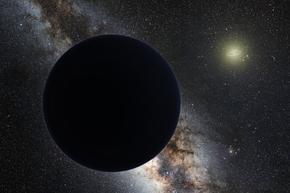 Artist's impression of Planet Nine eclipsing the central Milky Way, with the Sun in the distance; Neptune's orbit is shown as a small ellipse around the Sun (See labelled version) | |
| Orbital characteristics | |
|---|---|
| Aphelion | 560+260 −140 AU[1] |
| Perihelion | 340+80 −70 AU[1] |
| 460+160 −100 AU[1] | |
| Eccentricity | 0.2–0.5[2] |
| 9,900+5,500 −3,100 yr[A] | |
| Inclination | 16±5°[3] |
| 150° (est.)[4] | |
| Physical characteristics | |
| Mass | 6.3+2.3 −1.5 ME[1] |
| ~21[3] | |
Planet Nine is a hypothetical ninth planet in the outer region of the Solar System.[2][4] Its gravitational effects could explain the peculiar clustering of orbits for a group of extreme trans-Neptunian objects (ETNOs), bodies beyond Neptune that orbit the Sun at distances averaging more than 250 times that of the Earth i.e. over 250 astronomical units (AU). These ETNOs tend to make their closest approaches to the Sun in one sector, and their orbits are similarly tilted. These alignments suggest that an undiscovered planet may be shepherding the orbits of the most distant known Solar System objects.[4][5][6] Nonetheless, some astronomers question this conclusion and instead assert that the clustering of the ETNOs' orbits is due to observational biases, resulting from the difficulty of discovering and tracking these objects during much of the year.[7]
Based on earlier considerations, this hypothetical super-Earth-sized planet would have had a predicted mass of five to ten times that of the Earth, and an elongated orbit 400–800 AU. The orbit estimation was refined in 2021, resulting in a somewhat smaller semimajor axis of 380+140
−80 AU.[3] This was shortly thereafter updated to 460 +160
−100 AU.[1] Batygin & Brown suggested that Planet Nine may be the core of a giant planet that was ejected from its original orbit by Jupiter during the genesis of the Solar System. Others proposed that the planet was captured from another star,[8] was once a rogue planet, or that it formed on a distant orbit and was pulled into an eccentric orbit by a passing star.[4]
Although sky surveys such as Wide-field Infrared Survey Explorer (WISE) and Pan-STARRS did not detect Planet Nine, they have not ruled out the existence of a Neptune-diameter object in the outer Solar System.[9][10] The ability of these past sky surveys to detect Planet Nine was dependent on its location and characteristics. Further surveys of the remaining regions are ongoing using NEOWISE and the 8 meter Subaru Telescope.[11][12] Unless Planet Nine is observed, its existence remains purely conjectural. Several alternative hypotheses have been proposed to explain the observed clustering of trans-Neptunian objects (TNOs).
- ^ a b c d e Cite error: The named reference
Brown_Batygin_2021zwas invoked but never defined (see the help page). - ^ a b Cite error: The named reference
P9H2019was invoked but never defined (see the help page). - ^ a b c Cite error: The named reference
Batygin2021was invoked but never defined (see the help page). - ^ a b c d Cite error: The named reference
TAJ201601was invoked but never defined (see the help page). - ^ Cite error: The named reference
Sheppard2014was invoked but never defined (see the help page). - ^ Cite error: The named reference
fattywas invoked but never defined (see the help page). - ^ Cite error: The named reference
TC-20200525was invoked but never defined (see the help page). - ^ Cite error: The named reference
Mustill_etal_2016was invoked but never defined (see the help page). - ^ Cite error: The named reference
bnb20160617was invoked but never defined (see the help page). - ^ Cite error: The named reference
Luhman2014was invoked but never defined (see the help page). - ^ Cite error: The named reference
Meisner_etal_2017bwas invoked but never defined (see the help page). - ^ Cite error: The named reference
sciencemag201601was invoked but never defined (see the help page).
Cite error: There are <ref group=upper-alpha> tags or {{efn-ua}} templates on this page, but the references will not show without a {{reflist|group=upper-alpha}} template or {{notelist-ua}} template (see the help page).